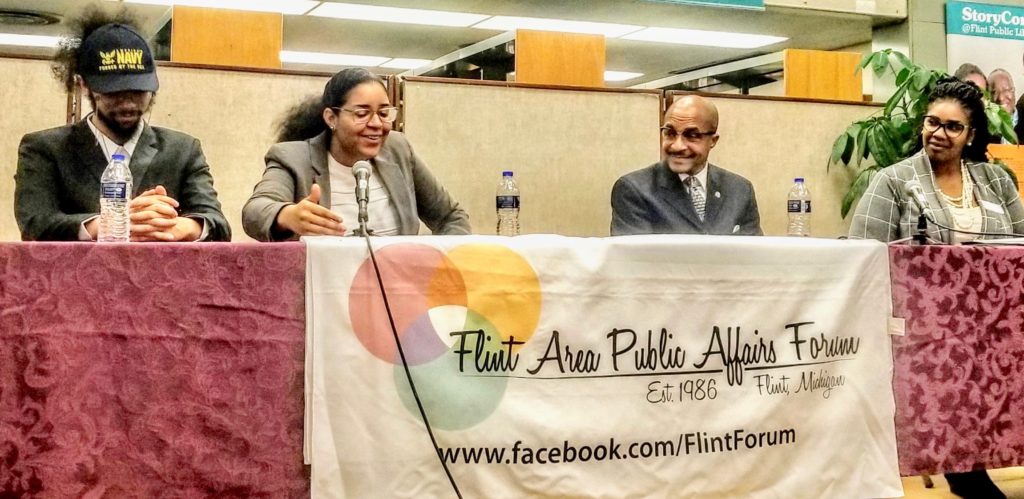By Jeffery L Carey Jr.
The panelists were unanimous in their views Tuesday night as Flint educators discussed social media related to children and their education: even though it creates complications, can be dangerous and needs careful monitoring, it’s going to be there “until the power goes out.”
Hosted by Flint Area Public Affairs Forum (FAPAF), the discussion at the Flint Public Library was sponsored by Baker College, Kettering University, Mott Community College, University of Michigan-Flint, Genesee Intermediate School District, Flint Community Schools, The Flint Club, Flint Public Library, and M-Live Media Group/The Flint Journal.
Jan 28’s event, titled, I saw it On Snapchat: Social Media and Children, yielded an audience of just 13 with Moderator Zahra Ahmad, of The Flint Journal, fielding questions.

From left, Derrick Smith, Kayla Wilson, Michael Pettigrew, Jonique Donald (Photo by Darlene Carey0
The panel was comprised of:
- Community School Director Jonique S. Donald of Flint’s International Academy,
- Pastor Michael L. Pettigrew of St. Paul Baptist Church, Moderator at Large of the Great Lakes Association, and Parental Liaison for the International Academy,
- Student Life Coordinator Kayla Wilson, an “interventionist” focusing on youth development, and student behavior at the International Academy, and
- Derrick Smith Jr. Senior IAF and the International Academy’s deputy head prefect of the Outreach Department.

How social media affects children through its use both in and outside of school was at the forefront of Donald’s discussion as she described how behavior on social media outside of the school sometimes spills over and creates negative outcomes on school grounds.
“Within the last 10 years,” she said, “there’s been more situations where young people have been able to utilize their cell phones and bring them to school.” She said she believes this is due to parents wanting to have access to their kids at school.
Some students do not make good choices, Donald said, and are using their phones to get on Facebook, Instagram, and Twitter. Because of this, Donald said, educators have to use academic time to deal with social situations as they relate to their students, parents, and the greater community.
Often students are pulled out of class to investigate actions that took place at home, Donald said. “Academic time is lost with students thinking they were innocent or shielded from consequences if they say different things or post certain things on social media from home then what does that have to do with the school.”
In fact, she said, it has everything to do with the school though and if it affects any of their children, parents, or teachers. “It has to be investigated,” she said.
This led to the problem of information being leaked outside of the school before teachers and administrators are even aware of a problem. One example cited was an incident when a fight broke out in the bathroom. Students video live streamed the fight on social media before anyone at the school was even aware of it.
Easy access to social media creates a variety of problems, the panelists said. Often the school has little damage control. This leads to parents and the communities becoming reactionary, as events are sometimes skewed by misleading posts and video before any investigations can be made.
Kayla Wilson weighed in, stating that kids today are “bound to social media.” She said most kids, starting at around first grade, now have a cell phone. This, Wilson said, means that they can “get into just about anything they want to.”
Wilson said the can create a problem with student behavior, especially with children in third to fifth grades.
“Kids get on YouTube,” she said, “and see things that are inappropriate for their age level and they started emulating that.” One a major problem with social media is bullying, she said.
“A lot of the beef,” said Derrick Smith Jr. of the fights in school, “starts with one kid posting, then another kid getting upset or feeling threatened.” Wilson agreed, observing that then the students “Stop focusing on learning and start focusing on a post.”
Another problem emerges, Smith said, when a student makes a mistake, especially during a sporting practice, that is captured on video by other students and placed on social media, causing tension among students. “I personally believe,” Smith said, “that social media should not be in reach with kids in middle school and elementary.”
Pettigrew brought up how children now can use social media and their cell phones to manipulate their parents.
“As a liaison I have the opportunity to meet with the kids as well as the parents,” he said. “There used to be a time where you could take the child home and speak to the parent. Now,” Pettigrew said, “They’ll set the tone by already having made a statement.”
Pettigrew said students will text their parent or send them a picture that is out of context or misleading, causing a negative response from the parents who accuse the teachers and administrators of “painting a negative picture of their child.”
Wilson also talked about the more recent social media platform TikTok and how children are getting on this site, recording themselves, and then publishing content online that will never go away. Often this content is something they will likely regret later in life, she said.
“Some kids do learn,” Wilson said, “as it trickles into school.” An unfortunate example of this was of a student who had gotten intoxicated at a party. While at the party she decided to have sex with another student. Without her knowledge another student video live streamed the two of them having sex. “They’re just not aware of how dangerous social media can be,” she said.
Another point raised by Wilson was how social media are being used to abduct children. Many predators are using social media to abduct and traffic children by setting up fake identities, befriending children online, and then convincing them to meet them. “Students, after just three or four days are willing to go meet with them.”
Despite the drawbacks, Donald acknowledged social media can be a great tool as well, especially if used correctly for teaching and learning. All of the panelists agreed that parents needed to be involved and monitor their children on social media whether the parent used social media or not.
One resource Donald’s recommended was, Ok2Say, a “student safety program which allows students to confidentially report tips on potential harm or criminal activities directed at school students, school employees, and schools.”
Ok2Say uses “a comprehensive communication system to facilitate tip sharing among students, parents, school personnel, community mental health service programs, the Michigan Department of Health and Human Services, and law enforcement officials about harmful behaviors that threaten to disrupt the learning environment,” she said.
Wilson also described a curriculum being used at Flint’s International Academy called, Character Strong. It’s a California based curriculum that has been in use for about ten years.
“It’s just another way that social media is helping educators like ourselves to educate our students about social and emotional learning,” Wilson said. She said the curriculum helps students learn to navigate social media and that the program has been eliciting some positive feedback.
For now, the panel members agreed, social media is just something we are going to have to deal with. “It’s going to be there until the power goes out.”
Banner photo by Darlene Carey, from left: Zahra Ahmad (at podium), Derrick Smith, Jr., Kayla Wilson, Michael L Pettigrew, Jonique Donald.
EVM Staff Writer Jeffery L. Carey, Jr. can be reached at jlcareyjr@hotmail.com.


You must be logged in to post a comment.